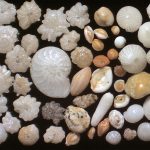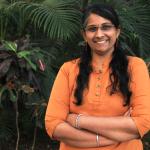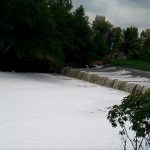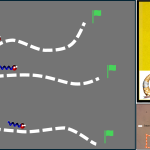Attreyee Ghosh and her team dig deep to unravel the secrets of the ground beneath our feet

When Carole King sang, “I feel the earth move under my feet,” she didn’t mean it in a literal sense. But she was right: the planet’s interior is dynamic. Yet, we seem to know little about what is happening deep inside – even as we explore other faraway planets and stars – although we are occasionally reminded of its intense activity whenever an earthquake or a tsunami strikes.
Attreyee Ghosh, Associate Professor at the Centre for Earth Sciences (CEaS) at IISc, agrees. “We still know very little about the structure of Earth,” she says. Besides its inaccessibility, the reason why we are so ignorant about the interior of our planet, according to her, is that it is “freaking complicated.” It has multiple layers, both liquid and solid, and each layer consists of several different minerals and rocks. “Each [layer] has different properties,” she says, and each of them is subjected to multiple forces. It is therefore not surprising that Earth Sciences encompass not just geology but also physics, chemistry and biology.
Attreyee’s research interest lies in understanding the physical processes taking place inside Earth and how they affect what we see on the surface. Using satellite and field data, she and her team build numerical models to understand these processes. This area of research is known as computational geodynamics. “I am very interested in how the deep interior talks to the surface,” she says.
One such surface feature that scientists have observed is the uneven face of Earth. The bumpiness results from the effects of gravity stemming from the unevenly distributed mass deep within Earth’s interior. If there were no tides or currents, all the water in the oceans would settle on this uneven surface giving Earth a peculiar shape that geophysicists call the “geoid”. An example of such an irregularity is seen just south of the subcontinent in the Indian Ocean where the ocean surface drops by over 100 m. Using satellite data, which record small fluctuations in the gravity field, Attreyee’s group has discovered the cause of this “geoid low”, which has in the past been a subject of much speculation. “There is a lot of low-density hot material in the mantle [layer of rocks between the core and Earth’s crust], and this low-density structure is causing the dip in the geoid surface,” she explains.

Yet another surface phenomenon, one that all of us are familiar with, are earthquakes, which have also attracted the attention of Attreyee’s lab. About nine out of 10 earthquakes occur at the boundaries of tectonic plates, the rigid blocks of the outermost part of Earth called the lithosphere. But sometimes, anomalous earthquakes happen in the middle of the plate, far away from plate boundaries. An example of such an intraplate earthquake was the devastating Gujarat earthquake of 2001. Attreyee’s work has shown that stresses originating at plate boundaries can travel through the plate interior and trigger such quakes.
Attreyee’s investigations, as well as those of others in her field, will help us better understand the structure of Earth’s interior. Besides generating more realistic 3D models of the ground beneath our feet, it will also aid seismologists in their quest for what she refers to as the “holy grail of geophysics”: prediction of earthquakes. These models will also be of tremendous help to design policies related to how we manage disasters, including safety regulations for construction and evacuating people.
Attreyee has come a long way in her career as an earth scientist. But she may not have ventured into the world of rocks had it not been for a gift she received from her father when she was still in school. It was a book titled Antarctica, written by Sudipta Sengupta, a geologist and former professor at Jadavpur University, and one of the first Indian women to go on a voyage to the icy continent. Reading about Sudipta’s experiences in the South Pole and how she became a geologist played a crucial role in shaping her own career, reminisces Attreyee. “I got interested in the subject after reading the book. At that age, I found it really fascinating. I knew I wanted to do science, but I didn’t exactly know which career to choose. That book helped me to channel my interest in this field [Earth Sciences].”
Attreyee did her PhD in geophysics from Stony Brook University in the USA and her postdoctoral research from the University of Southern California and Stony Brook University before she moved to CEaS as Assistant Professor in 2012.
The transition from postdoctoral studies where she focussed mainly on her own research to running her own lab at IISc has been challenging. “You cannot just think about a single project, you have to think about multiple students engaged in various different projects. Along with this comes administrative roles, and finding ways to fund your research,” she says.
However, over the years, she has eased into the role and looks forward to an exciting future – one in which she wants to continue to explore the relationship between deep and shallow forces in the interior of Earth and how they shape the surface. She is also grateful for the support that she received at an early age to pursue this path, and hopes that she can find ways to inspire more young girls to take up science.







